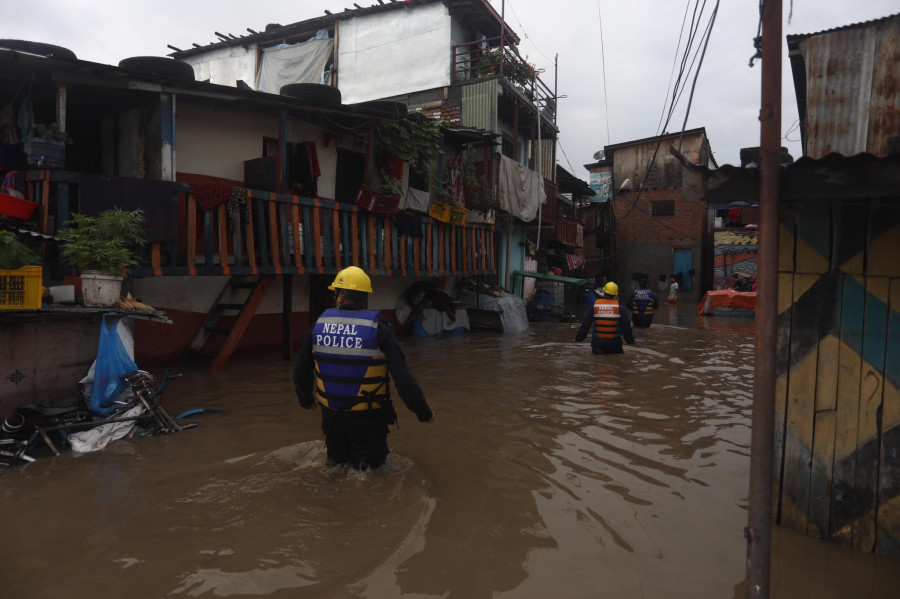National
Ongoing spell of rain could stay at least until Friday, predicts weather office
Rains that started in western Nepal are moving towards the east and the low-lying areas of provinces 1, 2, and 5 and Bagmati are most vulnerable to possible loss of life and property.
Chandan Kumar Mandal
The current spell of widespread rainfall will continue for a few more days until Friday, concentrating on the eastern and central parts of the country, according to the latest prediction of the Meteorological Forecasting Division.
“The impact of the current weather phenomenon that had started from the western part of the country will now slowly move towards the central and eastern regions from Wednesday onwards,” said Samir Shrestha, a meteorologist with the Division. “Its impact will be less in the western parts of the country.”
As per the latest forecast available up to Thursday, places of Province 1, Province 2, Bagmati Province and Gandaki Province will receive heavy rains in the coming days.
“The rainfall is likely to be more concentrated in areas below the Mahabharat hills, in the Chure and Siwalik ranges and the Tarai districts,” said Shrestha.
Consequently, there is a prediction of floods in the rivers of these provinces as well as in Province 5, according to the Department of Hydrology and Meteorology.
The incessant rainfall starting Sunday has affected most places in the country so far, claiming lives, damaging roads and bridges and flooding several settlements in the Tarai and in the Kathmandu Valley as well. There have been 71 water-induced disaster incidents between Sunday and Monday morning, according to the National Disaster Risk Reduction and Management Authority.
Although the country has received widespread rainfall, there has been no record-breaking rainfall for a particular area, say meteorologists.
“There has been much rain across the country if we look at the rainfall data of the last three days,” said Indira Kadel, a senior divisional meteorologist at the Department of Hydrology and Meteorology. “However, there has not been record rainfall for a particular day anywhere so far this monsoon season.”
A monitoring of rainfall data by the department shows the record for maximum rainfall in 24 hours for July is 308.3mm at Lumle in Kaski in 2017. The highest single day rainfall ever recorded in Nepal is 423.1 mm in Surkhet on August 15, 2014.
However, the amount of rainfall in a short period of time in most of the places has been significant in the past few days.

From Sunday morning till Monday 8:45 am, of the total 222 weather stations across the country, which keep rainfall data, 198 had recorded rainfall, with the highest being 169mm in Gharedhunga of Kaski district, indicating the spread of rainfall across the country. Three stations in Nawalpur, Bara and Kaski districts had marked over 150mm precipitation and other 23 stations more than 100mm.
The trend continued until Tuesday morning, when 177 stations had received rainfall, with the highest rainfall recorded at Makwanpurgadhi station of Makwanpur district with 199.2mm of rainfall. Four other stations had crossed the 150 mm mark and 17 went past 100mm level. Likewise, 51 stations received 50mm of rainfall between Monday and Tuesday morning.
According to Kadel, who is also the chief of the climate analysis section at the Met department, rainfall of anything over 50mm is generally considered heavy, but it could be location-specific.
“For instance, 50mm of rainfall could be record-breaking for Mustang, which receives the lowest annual rainfall in the country,” Kadel told the Post. “For districts like Kaski, which receives around 4,000mm annual rainfall, 50mm could not be considered heavy rainfall. But heavy rainfall in a short span of time could have damaging consequences.”
According to Kadel, Suryapura station of Rupandehi, which had clocked 192.2mm rainfall in the 24 hours till Tuesday afternoon, had received 140mm of rain in one hour between 10 and 11 pm.
“The high-intensity rain causes soil erosion and brings sedimentation with the floodwater. It can trigger flash floods and inundation quickly,” she said.
As the impact of climate change rainfall patterns has been changing in the country lately, a government study has shown an increasing gap between dry and rainy days even when the total annual rainfall has been constant.
This means there have been instances when a few days of continuous rainfall have almost reached the total average monthly rainfall of particular places causing more damage to life and property.
In an attempt for better preparedness for response to water-induced disasters, the National Disaster Risk Reduction and Management Authority was established within the Ministry of Home Affairs last year. It now works with the Department of Water Resources and Agriculture, Department of Mines and Geology and Department of Hydrology and Meteorology to inform the public of looming weather extreme events, raise awareness, better their response and minimise the damage. This year it has already sent a total of 5,017,233 SMS alerts to vulnerable communities, to warn them of impending dangers.




 17.12°C Kathmandu
17.12°C Kathmandu

%20(1).jpg&w=200&height=120)













